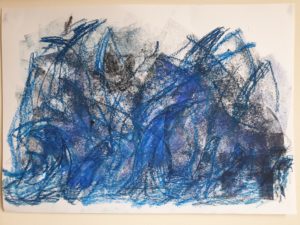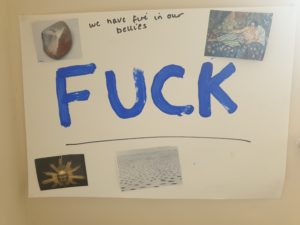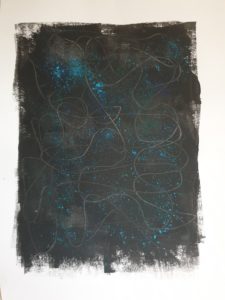This essay is an attempt to pull together some of the sprawling thoughts and inspirations that impact the way I work as an Art Therapist. I believe in working in a way that does not pathologise distress or human experience and that seeks to acknowledge the wider contexts and social inequalities that can harm us. I am always learning and have learnt so much from survivors and activists in this movement. Art making i s an innately human instinct and is often a highly effective way of communicating and exploring our traumatic experiences. When we engage with art materials in a safe environment the process may evoke different feelings which reflect the unconscious forces that shape our experience.
s an innately human instinct and is often a highly effective way of communicating and exploring our traumatic experiences. When we engage with art materials in a safe environment the process may evoke different feelings which reflect the unconscious forces that shape our experience.
There are some of my own images/art works scattered throughout this essay because for me, it is image making that often helps me stay in contact with the passionate and sometimes rageful activist within me. I witness the power of image making for myself and the people I work with. I hope the images add a sense of feeling to my writing.
I thought I would start off by describing what an Art Therapist is. In my writing I certainly do not speak for all art therapists and others may work and think in different ways, finding inspiration in different therapeutic models. Art Therapy is rooted in Psychotherapy and the Arts. The art can be visual but also includes writing, poetry and many different forms of expression. Nearly all art therapists have done an art degree of some kind before moving on to study art therapy. I believe having roots in the visual and artistic world helps me view psychological distress in an open–minded and meaningful way. Having explored my own art practice means that I have also been exploring my own internal world. Having the privilege of playing and making in a studio for 3 years on my fine art course was invaluable for my own self-awareness. This kind of exploration of course does not need to happen within the context of a university degree; many people have a rich art practice without any formal training. Being an artist helps me stay in touch with curiosity, playfulness and metaphor. To practise as an art therapist, you must be in your own therapy for at least two years. This was an invaluable resource as I learnt about the relationships that have shaped me, my own unconscious bias and my own distress. I am aware that not everyone has an overall positive experience when they see a therapist and there is huge variation in how therapists practise. For me personally, regular therapy has helped me gain confidence and feel safe to be emotional.
Art therapy often uses the language of metaphors. I’ve had the privilege of being down wells, in capsized ships, inside a doll’s house, surrounded by giants, wearing multiple masks. The person that I work with and I can spend time together in waves, in the depths, in craters or holes, in the sky, folding and unfolding maps, digging/burying in the sand and much more. One person described the art therapy room as the room of possibilities.
It is important to me that the art therapy room feels different to other clinical spaces, I want it to have that art studio feel. For some this is exciting and for others this can stir up difficult feelings of how they experienced art at school. Perhaps you remember a judgemental teacher or a feeling of not being good enough. We must be aware of what art making feels like for us and what feelings just being in a studio–type room can bring up. The images we make are incredibly personal and meaningful and they must be treated with respect. The art work in art therapy is confidential, and is kept safe by the therapist. Valuing the art work is important as hopefully it demonstrates valuing the person too. When therapy ends, the person can take the art work with them if they want. I think there can be something powerful about being able to take away a portfolio of art work that has been witnessed and that has expressed something really emotional about someone’s story. I do not interpret or translate art work, I show curiosity and reflect with the person on what might be being evoked in the art work. Being playful is a huge part of art therapy. Having a space to playfully test things out, get things wrong and work with materials that have a life of their own can be a great practice ground for life. We can often start to see ourselves and our experience differently through this process of making.
When I was studying my MA in art therapy I remember thinking: When are they going to teach us the real science stuff, you know, the brain and all the different diagnoses..? I completely understand now why that was not part of the work. I am not fluent in that medical language at all and I am so grateful for that. Instead in my studies/training I had the chance to practise some very human skills, being alongside someone who is distressed, listening and valuing all experiences in whatever form they are expressed. I think something art therapy training could highlight more is, the social injustices and inequalities that lead to such distress, and the links between experiencing psychological distress and poverty, abuse, oppression, sexual assault, social inequalities and many more forms of violence. Let’s talk about imbalances in society rather than imbalances in our brains.
 Currently I work in NHS mental health services. Something I have to do in my work within the NHS is hold onto rage. This is stirred up when working in a system which at times does not appear to share my values. The image on the left, Fuck, was made in a supervision session where I was feeling this rage particularly strongly. We have fire in our bellies, for me relates to the fire and passion that I witness and feel in communities like MadintheUK and A Disorder 4 Everyone. It is that fire and passion that helps me keep fighting for change and more choice in the current medical model.
Currently I work in NHS mental health services. Something I have to do in my work within the NHS is hold onto rage. This is stirred up when working in a system which at times does not appear to share my values. The image on the left, Fuck, was made in a supervision session where I was feeling this rage particularly strongly. We have fire in our bellies, for me relates to the fire and passion that I witness and feel in communities like MadintheUK and A Disorder 4 Everyone. It is that fire and passion that helps me keep fighting for change and more choice in the current medical model.
Something I can do when I am feeling rageful and helpless is notice language and try to use a different one, an alternative to the dominant medical script. I always seek to use more ordinary language, bringing the person’s own words and metaphors in. It can be painful to hear a person’s detailed and often very meaningful description of their feelings or distress being reduced to a symptom. This change in language is significant because it could encourage a bigger change, such as the understanding of why someone’s distress might have developed to start with. A supervisor of mine talks about letting a different kind of language ‘infuse’ into the system. If those of us who can, speak up at meetings/ward rounds/tribunals then hopefully this more curious, less judgemental, more contextual and authentic way of describing distress will emerge. We must make sure that there is space to understand distress in meaningful ways. For some, this may include a diagnosis or a label and for others it needs to be something wider/more expansive, a story that includes all aspects inside of us and outside of us.
I recently had some time off work as I was having chest pains, due to stress. I noticed I had started suppressing some of my feelings — if I felt tearful at home I would snigger or giggle instead. I wonder if this is something about working within a system that doesn’t always leave space for people’s emotions. I’m sure partly it’s my own fear of being vulnerable when sharing my feelings with my partner but I think working within mental health services has impacted on this too. The current pandemic has also had an impact on my ability to feel my feelings. There’s been this idea that we need to stay strong and carry on. With my time off I tried to stay in contact with my feelings, I spent a lot of time art making, visiting the sea and walking. (As well as watching a lot of Netflix!). Is there a fear of feeling in mental health services? To me it often feels like there’s a dampening down of people’s strong emotions, both of staff and of people who seek help from services. Is it not okay to feel things deeply? My hope is that art therapy and art making feel like a permissive and creative space where feelings can safely surface or where we can safely visit the depths. At times to help us cope, we may need to avoid the depths, and this is a valid way to cope and survive. No one should feel as though they must visit the depths or disclose their history. It is important that each of us can own our story and be in charge of how it is shared.
 The image on the left was one I made towards the end of my time off work, I felt as though I had managed to acknowledge my depths and sink below the surface, which felt like a huge relief. Often within services time is not given to do this, and you remain on the surface while the waves crash onto you. What I feel able to do in Art Therapy with people, is to press pause and be curious about those depths.
The image on the left was one I made towards the end of my time off work, I felt as though I had managed to acknowledge my depths and sink below the surface, which felt like a huge relief. Often within services time is not given to do this, and you remain on the surface while the waves crash onto you. What I feel able to do in Art Therapy with people, is to press pause and be curious about those depths.
I recently re-watched the ‘Still Face Experiment’ by Dr. Edward Tronick, in which a mother switches from responding to and mirroring her baby to holding an expressionless ‘still face’. The baby quickly becomes distressed and after trying several ways to regain the mother’s interest in the end turns away/gives up. It is not an easy video to watch but it got me thinking, I wonder how often services give off that still face that we know can be so damaging? How different are the ‘still face’ and the ‘professional face’? It is important that we show warmth and compassion rather than a cold blank slate expression, and the same goes for the language we use and the way we speak.
I wanted to share how I try to hold onto that fire in my belly. I make art, I stay in touch with allies. I keep asking questions and infusing that different, less medical and more compassionate language. I accept that I am always learning and do not have the answer. Groups like MadintheUK and A Disorder 4 Everyone keep my activism alive. The poetry nights organised by A Disorder 4 Everyone have been inspirational. I find it really nourishing to stay in contact with others who feel a similar passion.
Art Therapy is not currently a staple in mental health services, in the NHS Art Therapists are not equally represented. I think that is a huge loss as there needs to be a choice of therapies in services. If I was looking for a private therapist, I would meet a few and get a feel for what approach most suited me. There is not this luxury in the NHS. Those seeking help are often offered a very limited set of choices when it comes to therapy. What message does that lack of choice give to those seeking help?
I want to finish by sharing some words written by Lydia Daisy. Your beautiful words have been swimming around in my mind since I heard you perform your poem. Thank you for sharing it last year at one of the zoom poetry nights. The following is just a short extract from the poem; I’d encourage everyone to read it in full in the We are the Change-Makers poetry book.
“I am an ocean
“I happen in waves
Motions and emotions
I feel so deeply
I am all of this
And more
And less
And more
And less
And more
And less
And more
And less
And more
And less”
Extract from, More and less of all of this by Lydia Daisy




I am reporting my own comment here as I ran out of space. I just wanted Lucy to know her essay has opened my eyes to the medical model as I try to weigh up whether or not to work privately or not when I graduate this Summer.
Lucy Hodgkiss, your essay is a clear call for awareness-raising in the field of mental health and I have enjoyed reading your thoughts. Thank you. I am a mature art psychotherapy student, due to graduate this Summer. I am wondering if I want to be working in the NHS or private practice. The pros and cons of each are stacking up evenly at the moment, I know I still have much more to discover. Your essay has open
James, I am in complete resonance with your words:
“It’s only now I understand the depth of work that was required of me to sit beside someone with their deepest pain and to meet it from an embodied place within myself”. Like you, I am glad the faceless language of some clinicians has been left in the wings so to speak. Thanks for your insight.
I am a third year part time Art Psychotherapy MA student, finishing my dissertation and compiling my professional portfolio.
I pressed report comment inadvertently, what I was attempting to do was reply to James Scurry’s response to this remarkable essay by Lucy Hodgkiss.
I did some training in using art at therapy (not quite art therapy as it was more structured exercises around particular themes). I used it a few times with people and it was fascinating for both me and the, “Client.”
I once helped someone express murderous rage with paper and crayon. The process was very calm, quite disgusting, and very effective.
This is a remarkable piece of writing Lucy. I really resonated with the way in which you work with your clients, and also remember in my own training wondering to myself when I was going to be taught about all the “scientific stuff” and the diagnoses. I’m very glad I never was. It’s only now I understand the depth of work that was required of me to sit beside someone with their deepest pain and to meet it from an embodied place within myself. Looking forward to reading more of your work! Have you shared this piece with NHS colleagues? I really encourage you to do so, even if it’s constructively critical of the medical paradigm. Kindly James